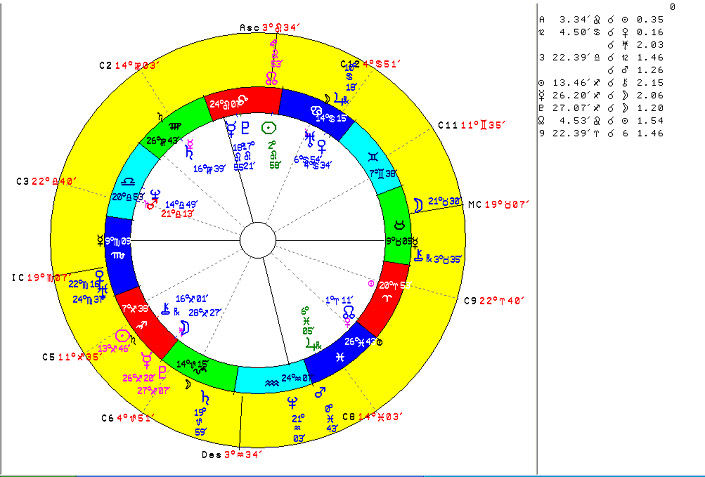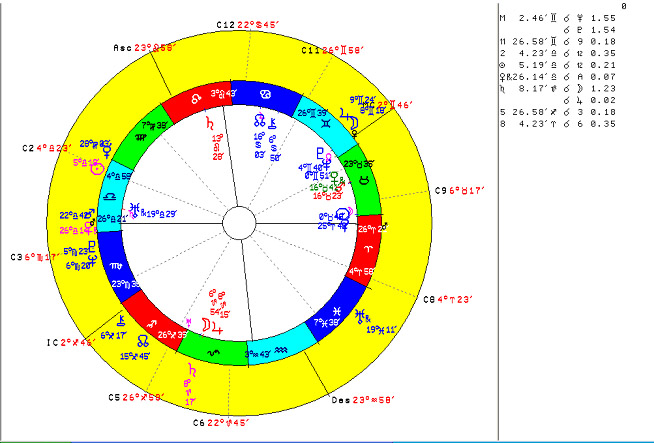
|
THE MUNDANE EQUIVALENT
Copyright © 2007 All Rights Reserved by Wim van Dam It is an old tradition in astrology that signs and houses are somehow analogous to each other: the first house is analogous to the first sign, Aries, the second house to Taurus, etc. In this article I want to show that there is an even closer relationship between them than has generally been supposed and that this relationship can be used to make the horoscope a tool of far more precision. In order to prove our thesis, we will go further than stating that, for example, a planet in the fifth house has an identical influence to the same planet in the fifth sign, Leo. We will convert each planet's position in the houses, its position in mundo, to the same position in zodiaco, in the signs: if a planet happens to be positioned exactly halfway in the fifth house, we give it a zodiacal longitude of 15 Leo; if it is positioned at the very beginning of the tenth house, at the MC, it will get a longitude of 0 Capricorn and a planet exactly in the ascendant will get a longitude of 0 Aries. Thus a complete set of alternative, mundane longitudes for the sun, the moon, the planets, the node and other horoscopical points can be calculated. Experience teaches that most astrologers have little difficulty in understanding this planetary conversion from houses to signs. But the next step proves to be more complicated for many of our colleagues It is also quite possible to convert zodiacal cusps to mundane cusps, although at first sight this looks more like a trick. If, as our thesis says, signs are equivalent to houses, this means that also the beginning points of the houses, the cusps, are equivalent to the beginning points of the signs, 0 Aries, 0 Taurus, etc. This means that if in the horoscope point 0 Aries is positioned exactly halfway the fifth house, the mundane ascendant for that horoscope will be at 15 Leo. If the point 0 Gemini is positioned halfway in the tenth house, the mundane cusp three will be at 15 Capricorn, etc. Thus, besides of the sun, moon and planets, we may also calculate the mundane equivalent of the cusps which means we can calculate for each horoscope a complete mundane equivalent with all cusps and planets that is a complete horoscope in itself. Important information about mundane horoscope: if you calculate one and repeat the calculation for the same date and place but for four minutes later, you will see all positions, both the cusps and the planets, progressed backward by about one degree. This is not difficult to understand. Just realize that when the sun is at the ascendant it will have a mundane longitude of 0 degrees Aries equals 30 degrees Pisces. Roughly four minutes later it will have risen upward a little in the twelfth house and it will have a mundane longitude of about 29 Pisces. Then, four minutes later, it will have risen to a mundane longitude of 28 Pisces, etc. The same with the mundane cusps, they too progress backward at a speed of about one degree every four minutes of time. A little consideration will show that this horoscope shows a far more individual nature than the usual radix. As we have seen, roughly every four minutes not only its cusps' positions will progress backward by about one degree but also its planetary positions, a situation that we astrologers are not used to at all. Now you may suppose that the aim of this article is to promote the study of this mundane horoscope, to be calculated for each regular radix, and to show how far superior are the indications furnished by this horoscope, and how more exact and applicable are its results, just like proponents of midpoints, harmonics etc. have done in the past. On the contrary, never will I! For me, the traditional horoscope is the root, the natural object of all analysis, progressions and whatever treatment you want to apply on it. In the same way, I do not think we should consider the mundane equivalent as a more personal, more refined horoscope that should be interpreted on its own. We should always compare it to the radix by means of whatever conjunctions happen to be made between the mundane positions and the radical ones. Under certain conditions, I have even found an orb of more than three degrees acceptable.
We will now proceed to our first example:  Mainly with didactical purpose, we will now discuss several mundane positions from this horoscope: An easy case too is Saturn's position. Radically it is 'somewhere' in the tenth house, slightly passed the middle, after conversion this proves to be a mundane position of 19.59 Capricorn which is in the radix's third house, and that's where we draw it in the outer circle. It does not make any conjunction to the radix and therefore we draw it in blue. Mercury and Pluto are a bit at the end of the ninth house and prove to be at mundane positions of 26.20 and 27.07 Sagittarius respectively, both conjunct to the radical moon at 28.27 Sagittarius, and both drawn in red. I take Pluto's position, as the ruler of the ascendant, conjunct to the moon (feminine part of life in a man's horoscope and my ruler of nine) in Sagittarius as an indication I was destined to marry a foreign girl (my wife is polish) and Mercury's conjunction to the same moon as an indication I was to become a writer on occult subjects: Mercury rules eight and is conjunct to Pluto, the natural ruler of eight. The point 0 Aries is at the beginning of the fifth house, so my mundane ascendant is at 3.34 Leo, a conjunction to the sun in nine. The (mean) node is radically at 1.10 Aries, a bit further in the same fifth house, so its mundane position is a bit past the mundane ascendant at 4.53 Leo, also in a conjunction to the sun in nine. The ascendant and the node that is radically in five, in nine in Leo conjunct to the sun, are once more signs of foreign love affairs. An unexpected effect of planetary latitude is shown below: in my radix the transgressional opposition moon-Venus has an orb of six degrees but the mundane positions are almost exactly opposite. Note however that none of these make any conjunction to a radical point, so color them blue. By now, the technique should be clear so now we can pass to the next example, John Allen Muhammed, better known as The Washington Sniper: I took this horoscope from http://www.skyscript.co.uk/sniper.html where Robert Corre gives the birthtime as derived from the birth certificate so we can be reasonably sure of its precision.  The first thing that strikes us is the fourfold rulership conjunction in intercepted Capricorn in the first house. The sun's and Mercury's partaking in this conjunction is not so fatal but Jupiter's position in the sign of its fall, being the ruler of the ascendant and conjunct to its ruler Saturn, clearly is a disaster. Robert Corre, as may be expected, gives a very good, be it verbose, Morinic analysis of this horoscope but he sensibly has problems with Saturn in Capricorn since a planet in its own sign according to Morin generally is a benefic. In order to explain why this stellium nevertheless is a bad constellation he has to take resource to Mars, opposing the sun, Mercury and Jupiter, stating that Mars is the exaltation ruler of Capricorn and is positioned in the sign of its fall. If however we accept the idea of the rulership conjunction then we see an opposition of four planets, including malefic Saturn in its own sign, to malefic Mars in the sign of its fall. In AstroSynthesis, p. 89, we read: "Likewise, the trine of Saturn in Domicile is constructive, its square destructive; on the other hand, when in Detriment, its trine gives no help, and its square is disastrous". From this we see that according to Morin the opposition from Saturn in Capricorn, although its own sign is destructive. It will be much more so since it is an opposition to Mars in the sign of its fall. For a further clarification on this difficult subject, read the footnote on p. 89 of AstroSynthesis. In Corre's analysis one element is lacking: why did exactly this man evolve to a perilous sniper? Weren't there born in New Orleans other people too at about the same time, or at the same time in other places? Why did these other people become more or less decent civilians? Here we see the power and the importance of the mundane equivalent: in this horoscope mundane Mars is conjunct to the radical MC, which both stresses and individualizes the importance of the opposition we discussed above. Mundane Pluto is conjunct to radical cusp 12 which may be called very applicable for one who proved to be a lethal hidden enemy for at least 18 people. Please remember that every four minutes of time mundane positions change by about one degree and you will realize just how individual are these two indications, and what a coincidence it is that both Mars and Pluto, natural rulers of Scorpio, are involved. Noteworthy also is the position of mundane Jupiter at the IC. This indication in itself is not so powerful but since mundane Mars is at the MC it repeats, stresses the opposition between Mars and Jupiter in the radix. Remember, both planets are radically in their fall. Thus we see that mundane positions not only further clarify what we know about the native, they also make the indications more personal and individualized. Our third and last example will be once more the horoscope of Adolf Hitler: 
I hope the reader, from the above examples, will understand how important the mundane equivalent can be in the radical analysis of a horoscope. Just how important they can be in another branch of astrology will be the subject of the next article in this series. References:AstroSynthesis, The Rational System of Horoscope Interpretation according to Morin de Villefranche, Translated by Lucy Little. Zoltan Mason Emerald Books, New York 1974.
|

 AUTHOR:
AUTHOR: 